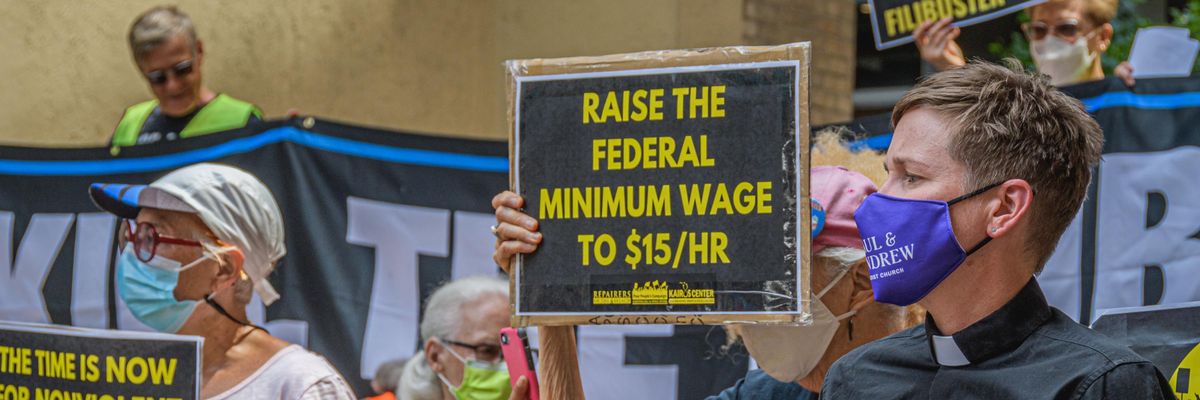
Demonstrators with the Poor People's Campaign hold signs at a protest in Manhattan on July 26, 2021. (Photo: Erik McGregor/LightRocket via Getty Images)
To donate by check, phone, or other method, see our More Ways to Give page.

Demonstrators with the Poor People's Campaign hold signs at a protest in Manhattan on July 26, 2021. (Photo: Erik McGregor/LightRocket via Getty Images)
Efforts to raise the federal minimum wage to $15 an hour may have stalled, but a report out Monday shows that a record number of states, cities, and counties are set to boost their minimum wages in 2022--an indication that grassroots organizing for a higher pay floor is continuing to bring results across the United States.
"Twenty states have refused to raise their wage floors above the federal rate for over a decade."
In total, according to the new analysis by the National Employment Law Project (NELP), 81 U.S. jurisdictions will hike their minimum wages in 2022, raising base-level pay for millions of workers.
NELP noted in its report that in the new year, the minimum wage will reach or exceed $15 per hour in 17 cities and counties, including Washington, D.C. and localities in California, Illinois, Maryland, and Minnesota.
Rebecca Dixon, NELP's executive director, argued in a statement that the growth of the nationwide Fight for $15 movement--which began with mass walkouts in 2012--has been "accelerated by the pandemic's exposure of stark inequities and hazardous work conditions," leading to a striking upsurge in labor actions and union drives across the country.
"Underpaid workers, especially Black and brown workers, have been mobilizing to demand higher wages, safer workplace conditions, and dignified jobs--and they're succeeding," said Dixon. "Faced with a tight labor market, employers will have to act quickly in order to retain discontented workers."
NELP estimates that if current laws remain in effect, around 40% of the U.S. workforce will be covered by $15 minimum wage measures by 2026.
Yannet Lathrop, a researcher at NELP and the author of the new report, toldUSA Today that while the federal minimum wage remains stagnant at $7.25 an hour, $15 is "becoming the default minimum" in parts of the country thanks to persistent grassroots campaigning led by fast food workers and other low-wage employees.
"This is the result of that organizing," Lathrop said.
Related Content

In February, House Democrats passed a coronavirus relief package that would have raised the federal minimum wage to $15 by 2025, but Senate Democrats ultimately stripped the pay raise from the bill in deference to the unelected Senate parliamentarian, who argued the provision violated the upper chamber's arcane budget reconciliation rules.
Sen. Bernie Sanders (I-Vt.) later attempted to reattach the provision despite the parliamentarian's advisory opinion, but eight members of the Senate Democratic caucus joined Republicans in voting the Vermont senator's amendment down.
Since the failure earlier this year, congressional Democrats have not launched another attempt to pass the $15 federal minimum wage measure.
While stressing that workers nationwide have "made tremendous gains" since the Fight for $15 movement kicked off nearly a decade ago, Lathrop observed in the new report that millions of workers live in states and localities that have not taken action to raise their minimum wages, making "ongoing efforts to raise the federal wage floor... critical."
Lathrop also pointed to "possible ballot initiatives in Nebraska, Idaho, and California, which will give voters a chance to approve $15 to $18 minimum wages during the 2022 midterm elections."
"Twenty states have refused to raise their wage floors above the federal rate for over a decade," Lathrop wrote. "Roughly half of those states are located in the U.S. South, where a majority of Black workers live, and where, not surprisingly, they experience higher levels of poverty and downward economic mobility."
Trump and Musk are on an unconstitutional rampage, aiming for virtually every corner of the federal government. These two right-wing billionaires are targeting nurses, scientists, teachers, daycare providers, judges, veterans, air traffic controllers, and nuclear safety inspectors. No one is safe. The food stamps program, Social Security, Medicare, and Medicaid are next. It’s an unprecedented disaster and a five-alarm fire, but there will be a reckoning. The people did not vote for this. The American people do not want this dystopian hellscape that hides behind claims of “efficiency.” Still, in reality, it is all a giveaway to corporate interests and the libertarian dreams of far-right oligarchs like Musk. Common Dreams is playing a vital role by reporting day and night on this orgy of corruption and greed, as well as what everyday people can do to organize and fight back. As a people-powered nonprofit news outlet, we cover issues the corporate media never will, but we can only continue with our readers’ support. |
Efforts to raise the federal minimum wage to $15 an hour may have stalled, but a report out Monday shows that a record number of states, cities, and counties are set to boost their minimum wages in 2022--an indication that grassroots organizing for a higher pay floor is continuing to bring results across the United States.
"Twenty states have refused to raise their wage floors above the federal rate for over a decade."
In total, according to the new analysis by the National Employment Law Project (NELP), 81 U.S. jurisdictions will hike their minimum wages in 2022, raising base-level pay for millions of workers.
NELP noted in its report that in the new year, the minimum wage will reach or exceed $15 per hour in 17 cities and counties, including Washington, D.C. and localities in California, Illinois, Maryland, and Minnesota.
Rebecca Dixon, NELP's executive director, argued in a statement that the growth of the nationwide Fight for $15 movement--which began with mass walkouts in 2012--has been "accelerated by the pandemic's exposure of stark inequities and hazardous work conditions," leading to a striking upsurge in labor actions and union drives across the country.
"Underpaid workers, especially Black and brown workers, have been mobilizing to demand higher wages, safer workplace conditions, and dignified jobs--and they're succeeding," said Dixon. "Faced with a tight labor market, employers will have to act quickly in order to retain discontented workers."
NELP estimates that if current laws remain in effect, around 40% of the U.S. workforce will be covered by $15 minimum wage measures by 2026.
Yannet Lathrop, a researcher at NELP and the author of the new report, toldUSA Today that while the federal minimum wage remains stagnant at $7.25 an hour, $15 is "becoming the default minimum" in parts of the country thanks to persistent grassroots campaigning led by fast food workers and other low-wage employees.
"This is the result of that organizing," Lathrop said.
Related Content

In February, House Democrats passed a coronavirus relief package that would have raised the federal minimum wage to $15 by 2025, but Senate Democrats ultimately stripped the pay raise from the bill in deference to the unelected Senate parliamentarian, who argued the provision violated the upper chamber's arcane budget reconciliation rules.
Sen. Bernie Sanders (I-Vt.) later attempted to reattach the provision despite the parliamentarian's advisory opinion, but eight members of the Senate Democratic caucus joined Republicans in voting the Vermont senator's amendment down.
Since the failure earlier this year, congressional Democrats have not launched another attempt to pass the $15 federal minimum wage measure.
While stressing that workers nationwide have "made tremendous gains" since the Fight for $15 movement kicked off nearly a decade ago, Lathrop observed in the new report that millions of workers live in states and localities that have not taken action to raise their minimum wages, making "ongoing efforts to raise the federal wage floor... critical."
Lathrop also pointed to "possible ballot initiatives in Nebraska, Idaho, and California, which will give voters a chance to approve $15 to $18 minimum wages during the 2022 midterm elections."
"Twenty states have refused to raise their wage floors above the federal rate for over a decade," Lathrop wrote. "Roughly half of those states are located in the U.S. South, where a majority of Black workers live, and where, not surprisingly, they experience higher levels of poverty and downward economic mobility."
Efforts to raise the federal minimum wage to $15 an hour may have stalled, but a report out Monday shows that a record number of states, cities, and counties are set to boost their minimum wages in 2022--an indication that grassroots organizing for a higher pay floor is continuing to bring results across the United States.
"Twenty states have refused to raise their wage floors above the federal rate for over a decade."
In total, according to the new analysis by the National Employment Law Project (NELP), 81 U.S. jurisdictions will hike their minimum wages in 2022, raising base-level pay for millions of workers.
NELP noted in its report that in the new year, the minimum wage will reach or exceed $15 per hour in 17 cities and counties, including Washington, D.C. and localities in California, Illinois, Maryland, and Minnesota.
Rebecca Dixon, NELP's executive director, argued in a statement that the growth of the nationwide Fight for $15 movement--which began with mass walkouts in 2012--has been "accelerated by the pandemic's exposure of stark inequities and hazardous work conditions," leading to a striking upsurge in labor actions and union drives across the country.
"Underpaid workers, especially Black and brown workers, have been mobilizing to demand higher wages, safer workplace conditions, and dignified jobs--and they're succeeding," said Dixon. "Faced with a tight labor market, employers will have to act quickly in order to retain discontented workers."
NELP estimates that if current laws remain in effect, around 40% of the U.S. workforce will be covered by $15 minimum wage measures by 2026.
Yannet Lathrop, a researcher at NELP and the author of the new report, toldUSA Today that while the federal minimum wage remains stagnant at $7.25 an hour, $15 is "becoming the default minimum" in parts of the country thanks to persistent grassroots campaigning led by fast food workers and other low-wage employees.
"This is the result of that organizing," Lathrop said.
Related Content

In February, House Democrats passed a coronavirus relief package that would have raised the federal minimum wage to $15 by 2025, but Senate Democrats ultimately stripped the pay raise from the bill in deference to the unelected Senate parliamentarian, who argued the provision violated the upper chamber's arcane budget reconciliation rules.
Sen. Bernie Sanders (I-Vt.) later attempted to reattach the provision despite the parliamentarian's advisory opinion, but eight members of the Senate Democratic caucus joined Republicans in voting the Vermont senator's amendment down.
Since the failure earlier this year, congressional Democrats have not launched another attempt to pass the $15 federal minimum wage measure.
While stressing that workers nationwide have "made tremendous gains" since the Fight for $15 movement kicked off nearly a decade ago, Lathrop observed in the new report that millions of workers live in states and localities that have not taken action to raise their minimum wages, making "ongoing efforts to raise the federal wage floor... critical."
Lathrop also pointed to "possible ballot initiatives in Nebraska, Idaho, and California, which will give voters a chance to approve $15 to $18 minimum wages during the 2022 midterm elections."
"Twenty states have refused to raise their wage floors above the federal rate for over a decade," Lathrop wrote. "Roughly half of those states are located in the U.S. South, where a majority of Black workers live, and where, not surprisingly, they experience higher levels of poverty and downward economic mobility."